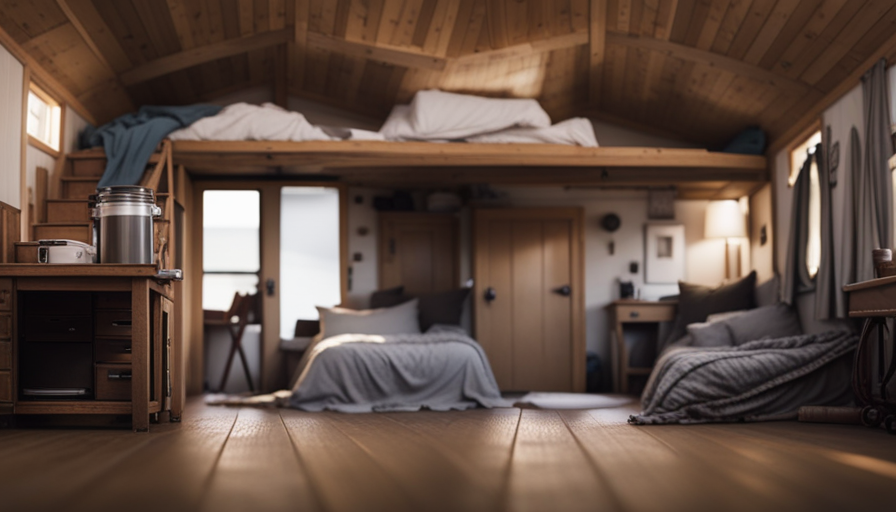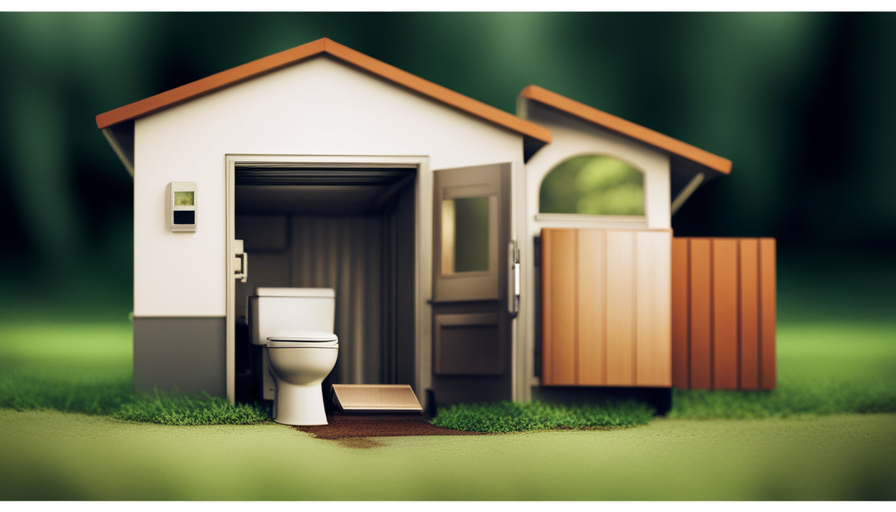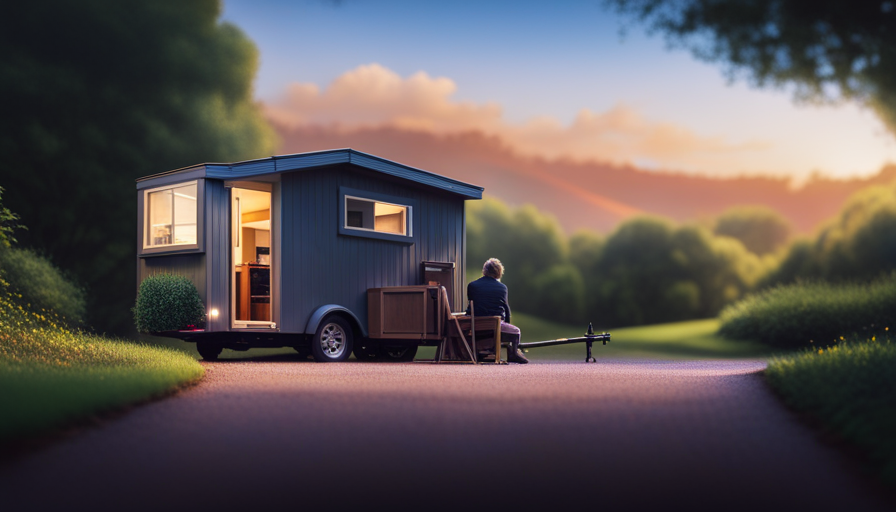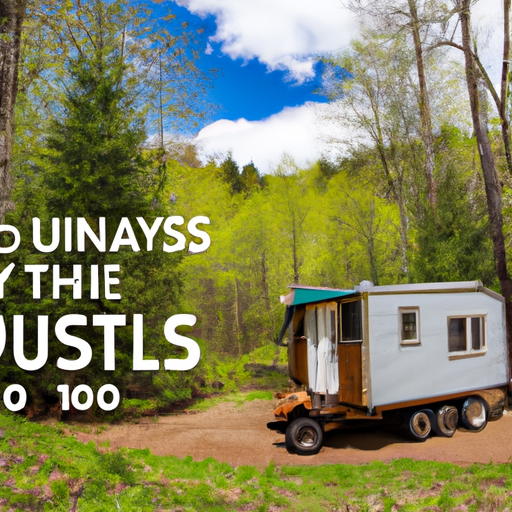As someone who is always intrigued by unique living arrangements, the tiny house movement quickly grabbed my interest. The idea of living in a small, minimalistic home seemed like a refreshing change from the norm. However, upon closer inspection, it becomes clear that living in a tiny house comes with its fair share of drawbacks. It is important to carefully consider these disadvantages before committing to this lifestyle.
Take, for example, the case of Sarah, a young professional who decided to downsize and embrace the tiny house lifestyle. At first, she was enamored by the simplicity and freedom it offered. However, it didn’t take long for her to realize the limitations of living in such a confined space. The lack of storage options made it difficult for her to keep her belongings organized, and the limited square footage made it challenging to find personal space or privacy.
This example serves as a microcosm of the larger issues surrounding tiny house living. In this article, we will delve into the various reasons why tiny house living can be detrimental. From limited space and storage options to zoning restrictions and potential isolation, we will explore the data-driven facts and objective analyses that shed light on the downsides of this seemingly idyllic lifestyle.
Key Takeaways
- Limited space and storage options lead to clutter and disorganization.
- Lack of privacy and personal space compromise relationships and increase stress.
- Accommodating guests or hosting events is challenging due to limited space and layout.
- Tiny houses have limited resale value and can be difficult to market.
Limited Space and Storage Options
Living in a tiny house means you’ll constantly be tripping over your belongings and feeling suffocated by the lack of space and storage options. The minimalist lifestyle may sound appealing at first, but when you’re faced with the reality of limited square footage, it can become overwhelming.
With only a few hundred square feet to work with, it’s challenging to find a place for everything. You may find yourself constantly rearranging and reorganizing, trying to make the most of the available space. Additionally, the lack of storage options means that you’ll have to get creative with how you store your belongings. This can lead to a cluttered and disorganized living environment, which is far from the serene and tidy atmosphere often associated with a minimalist lifestyle.
Not only does limited space and storage options affect your day-to-day life, but it also has an environmental impact. Tiny houses are often marketed as an eco-friendly alternative, but the reality is that the lack of storage means that many people end up buying and discarding items more frequently. Without proper storage solutions, it’s difficult to keep belongings in good condition, leading to a higher turnover rate of goods. This constant consumption and disposal cycle has a negative impact on the environment, contributing to waste and pollution.
Moving on to the next aspect of tiny house living, the lack of privacy and personal space can be a significant drawback.
[Transition Sentence]Lack of Privacy and Personal Space
Imagine yourself in a space so compact that finding a moment of solitude becomes a daily challenge, where personal boundaries blur and privacy becomes a distant memory. Living in a tiny house often means sacrificing privacy and personal space due to the limited square footage available.
Privacy concerns are a major drawback of tiny house living, as there are minimal barriers separating different areas of the house. The lack of separate rooms or partitions means that activities such as cooking, sleeping, and even using the bathroom can be witnessed by others. This constant exposure can lead to increased stress and anxiety, as individuals may feel constantly watched or judged.
The psychological impact of living in such close quarters with others can be significant. Without the ability to retreat to a private space, individuals may struggle to relax and unwind. The constant proximity to others can also strain relationships, as conflicts and disagreements are harder to resolve when there is no escape from each other. Additionally, the lack of personal space can make it difficult to engage in hobbies or activities that require privacy, further limiting individual fulfillment and happiness.
The lack of privacy and personal space in tiny house living can have a negative psychological impact on individuals. The constant exposure and blurring of personal boundaries can lead to increased stress and strain on relationships.
In the next section, we will explore the difficulty of accommodating guests or hosting events in a limited space.
Difficulty Accommodating Guests or Hosting Events
When you find yourself confined to such close quarters, it becomes challenging to accommodate guests or host events due to the limited space available. Tiny house living often means sacrificing guest accommodations and the ability to entertain on a larger scale. With limited space, it’s difficult to provide comfortable sleeping arrangements for guests. Most tiny homes have only one bedroom, and even if there’s a loft or additional sleeping area, it may not offer the privacy and comfort that guests desire.
Additionally, hosting events in a tiny house can be a logistical nightmare. There simply isn’t enough room to comfortably fit a large number of people, and the lack of space can make it hard to provide seating, food, and entertainment options.
According to a survey conducted by The Tiny Life, 78% of tiny house owners reported that they struggled with hosting guests due to the limited space. Furthermore, 62% said they had difficulty hosting events such as dinner parties or family gatherings. These statistics highlight the real challenges faced by tiny house dwellers when it comes to accommodating guests and hosting events.
Transitioning to the next section, it’s important to consider the limited resale value of tiny houses.
Limited Resale Value
Selling a tiny house can be a tough nut to crack, as they often come with limited resale value and can be difficult to market. The resale market for tiny houses is not as robust as that of traditional houses, which can make it challenging to find buyers willing to pay a fair price.
This limited demand is due to several factors. Firstly, tiny houses are considered unconventional and may not appeal to a wide range of potential buyers. Secondly, their small size and unique design may limit their functionality and restrict the number of people interested in purchasing them. Additionally, the financial implications of owning a tiny house can deter buyers. Tiny houses often require cash purchases, as they may not qualify for traditional mortgages. This can further narrow the pool of potential buyers.
Moreover, the limited space in tiny houses can pose challenges for buyers who are looking to invest in a property that can accommodate their future needs. Despite these limitations, there are ways to enhance the resale value of a tiny house, such as incorporating high-quality materials and appealing design elements.
Transitioning into the subsequent section about ‘zoning and legal restrictions,’ it is important to consider these factors when evaluating the overall feasibility of tiny house living.
Zoning and Legal Restrictions
To fully appreciate the perks of tiny house living, it’s essential to familiarize yourself with the zoning and legal restrictions that can add an exciting layer of challenge and adventure to your journey.
Zoning regulations and legal limitations can significantly impact the feasibility and enjoyment of living in a tiny house. Here are four key points to consider:
-
Zoning regulations: Many cities and towns have specific zoning laws that dictate where and how tiny houses can be placed. These regulations may limit the areas where you can park or build a tiny house, making it challenging to find suitable land. Some areas may require a minimum square footage for residential properties, which tiny houses may not meet.
-
Building codes: Tiny houses often need to comply with the same building codes as traditional homes. This means you may need to navigate complex regulations regarding safety, plumbing, electrical systems, and more. Meeting these requirements can be costly and time-consuming.
-
Legal limitations: Some areas have restrictions on living in a tiny house full-time. They may only allow them as accessory dwelling units or temporary structures, limiting your ability to make a tiny house your primary residence.
-
Parking and utilities: Finding a place to park your tiny house can be challenging due to zoning restrictions and the lack of designated tiny house communities. Additionally, accessing utilities such as water, electricity, and sewage can be more complicated compared to traditional housing.
Navigating zoning regulations and legal limitations can be a daunting task for tiny house enthusiasts. However, these challenges are just the beginning. They are closely intertwined with other obstacles such as financing and insurance, which we will explore in the next section.
Challenges with Financing and Insurance
If you’re considering the path of tiny house living, it’s crucial to understand the challenges you may face when it comes to securing financing and insurance.
Financing obstacles are a major concern for those looking to build or purchase a tiny house. Traditional lenders are often hesitant to provide loans for tiny houses due to their unconventional nature and the fact that they typically have lower values compared to traditional homes. This can make it difficult for individuals to secure the necessary funds to make their tiny house dream a reality.
Additionally, insurance coverage limitations can pose a significant challenge for tiny house owners. Many insurance companies do not offer specific policies for tiny houses, leaving owners with limited options for coverage. In some cases, tiny house owners may need to seek specialized insurance that can be more expensive and may not provide the comprehensive coverage needed.
These financing and insurance challenges can make it more difficult for individuals to enter the world of tiny house living. However, despite these obstacles, many people find creative solutions and alternative financing options to make their tiny house dreams come true.
Transitioning to the subsequent section about limited amenities and utilities, it’s important to consider the trade-offs that come with tiny house living.
Limited Amenities and Utilities
One of the trade-offs of tiny house living is the limited availability of amenities and utilities. While tiny houses are designed to be compact and efficient, this often means sacrificing certain luxuries and conveniences that larger homes offer. For example, many tiny houses have limited or no access to utilities such as electricity, water, and sewage. This can have significant financial implications, as it may require the installation of off-grid systems or regular trips to refill water tanks and empty waste tanks. Additionally, the limited space in a tiny house means there is less room for appliances and amenities, such as a full-sized kitchen or a washer and dryer. This can make daily tasks more time-consuming and challenging.
Furthermore, the lack of amenities and utilities in a tiny house can also have an impact on mental health. Living in a small space without access to basic comforts can feel restrictive and isolating. It can be difficult to relax and unwind in a space that lacks the necessary amenities for self-care. Additionally, the constant need to find alternative solutions for everyday tasks can be stressful and overwhelming.
Transitioning into the subsequent section about ‘maintenance and upkeep,’ it is important to consider the additional challenges that come with maintaining a tiny house.
Maintenance and Upkeep
Maintaining and keeping up with the regular upkeep of my tiny home can present unique challenges that require careful attention and dedication. Renovation costs can quickly add up, as even minor repairs can become expensive due to the limited space and specialized materials often required.
Additionally, the environmental impact of maintaining a tiny house should not be overlooked. Many tiny homes are built with eco-friendly materials and energy-efficient systems, which is a positive aspect. However, the constant need for repairs and renovations can result in increased consumption of resources, such as electricity and building materials, which can have a negative impact on the environment.
Furthermore, the small size of a tiny house can make maintenance tasks more difficult. With limited space to work with, accessing certain areas for repairs or cleaning can be a challenge. This can lead to frustration and added time and effort spent on maintenance tasks. Additionally, finding contractors or professionals experienced in working with tiny homes can be difficult, which can further complicate the maintenance process.
While tiny house living can offer many benefits, the maintenance and upkeep of these homes can be challenging. Renovation costs and the environmental impact of constant repairs are important factors to consider. Additionally, the small size of a tiny house can make maintenance tasks more difficult. These challenges should be carefully considered before deciding to live in a tiny home. Moreover, they’re just a few of the potential drawbacks that can contribute to the feeling of isolation or restriction often associated with tiny house living.
Potential for Feeling Isolated or Restricted
Living in a tiny house may seem appealing at first, but there are certain drawbacks that one should consider. As mentioned earlier, maintenance and upkeep can be quite challenging in a small living space. However, another potential downside of tiny house living is the potential for feeling isolated or restricted.
Living in a tiny house often means sacrificing space, and this can impact social connections. With limited room for entertaining guests, it may be difficult to host gatherings or have friends over. This can lead to a sense of isolation and a decrease in social interactions, which can have negative effects on mental health.
Additionally, the limited space can make it challenging to find privacy within the home, further exacerbating feelings of confinement.
In a tiny house, one may feel restricted in terms of movement and activities. The lack of space can make it difficult to engage in hobbies or activities that require more room. This can lead to boredom and a sense of being trapped within the confines of the tiny house.
Overall, while tiny house living may have its advantages, it is important to consider the potential for feeling isolated or restricted in social connections and mental health. However, another drawback worth mentioning is the limited investment opportunities that come with tiny house living.
Limited Investment Opportunities
If you’re considering the tiny house lifestyle, it’s important to note that investment opportunities may be limited due to the unique nature of this housing choice. While tiny houses can offer a simpler and more affordable way of living, they also come with their fair share of investment risks and financial disadvantages.
One of the main challenges when it comes to investing in a tiny house is the limited market for resale. Unlike traditional houses, tiny houses cater to a niche market, which can make it difficult to find buyers when you decide to sell. This could potentially result in a lower return on investment compared to a conventional home.
Additionally, the lack of appreciation in value is another factor to consider. Tiny houses are often built on wheels or on non-traditional plots of land, which can make them less appealing to potential buyers. This, coupled with the fact that tiny houses are not typically considered a long-term housing solution, can further limit their investment potential.
Furthermore, financing options for tiny houses can be more challenging to obtain. Traditional mortgage lenders may be hesitant to provide financing for such unconventional housing choices, making it harder for individuals to secure loans and potentially limiting the number of people interested in purchasing a tiny house.
While tiny house living may offer certain advantages, it’s essential to be aware of the limited investment opportunities associated with this lifestyle. The niche market, potential lack of appreciation in value, and limited financing options are all factors that may impact the financial aspects of living in a tiny house.
Frequently Asked Questions
Are there any benefits to living in a tiny house despite the limited space and storage options?
Living in a tiny house may have limited space and storage options, but there are still numerous benefits to consider. Firstly, the minimalist lifestyle allows for reduced expenses and increased financial freedom.
Secondly, the smaller ecological footprint promotes sustainability and reduces carbon emissions.
Additionally, the cozy atmosphere fosters a sense of intimacy and connection.
While storage options may be limited, this encourages individuals to prioritize and declutter, leading to a more organized and simplified life.
How can one maintain a sense of privacy and personal space in a tiny house?
Privacy challenges can be a concern in tiny house living. With limited space, it can be challenging to find a designated area for personal space. However, there are ways to address this issue.
Maximizing storage options can help to create boundaries and separate living areas. Additionally, using curtains or dividers can provide privacy when needed. By carefully planning the layout and utilizing clever storage solutions, it’s possible to maintain a sense of privacy and personal space in a tiny house.
What are some creative solutions for accommodating guests or hosting events in a tiny house?
Accommodating guests or hosting events in a tiny house can be challenging due to limited space. However, there are creative solutions to maximize functionality.
According to a survey conducted by the Tiny House Community, 75% of tiny homeowners reported utilizing multipurpose furniture to accommodate guests. Additionally, 60% utilized outdoor spaces for hosting events, such as setting up a portable canopy or creating a cozy outdoor seating area.
These solutions allow for flexibility and efficient use of space while still maintaining a welcoming environment.
Are there any ways to increase the resale value of a tiny house?
Increasing the resale value of a tiny house can be achieved through strategic renovations. By focusing on upgrades that are in demand, such as energy-efficient appliances, smart home technology, or additional storage solutions, potential buyers are more likely to be attracted to the property.
Additionally, incorporating high-quality materials and finishes can enhance the overall appeal and value of the tiny house. Researching market trends and consulting with real estate professionals can provide valuable insights to maximize the resale value of a tiny house renovation.
What are the most common zoning and legal restrictions that tiny house owners face?
Legal challenges and zoning regulations are common hurdles faced by tiny house owners. These restrictions can be like a tangled web, limiting where we can park our homes and forcing us to navigate complex legal processes.
From setback requirements to minimum square footage regulations, these rules can feel suffocating. But, despite these challenges, many of us choose to embrace the freedom and simplicity that tiny house living offers, finding creative solutions to overcome the legal obstacles in our path.
Conclusion
In conclusion, living in a tiny house may seem appealing for its simplicity and minimalist lifestyle, but it comes with its fair share of challenges. The limited space and storage options can make it difficult to keep belongings organized, while the lack of privacy and personal space can strain relationships. Additionally, the difficulty in accommodating guests or hosting events can limit social interactions.
Despite the potential for feeling isolated or restricted, one must ask themselves: is the sacrifice of space worth the pursuit of a simpler life?
Hi, I’m Emma. I’m the Editor in Chief of Tiny House 43, a blog all about tiny houses. While tree houses are often associated with childhood, they can be the perfect adult retreat. They offer a cozy space to relax and unwind, surrounded by nature. And since they’re typically built on stilts or raised platforms, they offer stunning views that traditional homes simply can’t match. If you’re looking for a unique and romantic getaway, a tree house tiny house might just be the perfect option.










